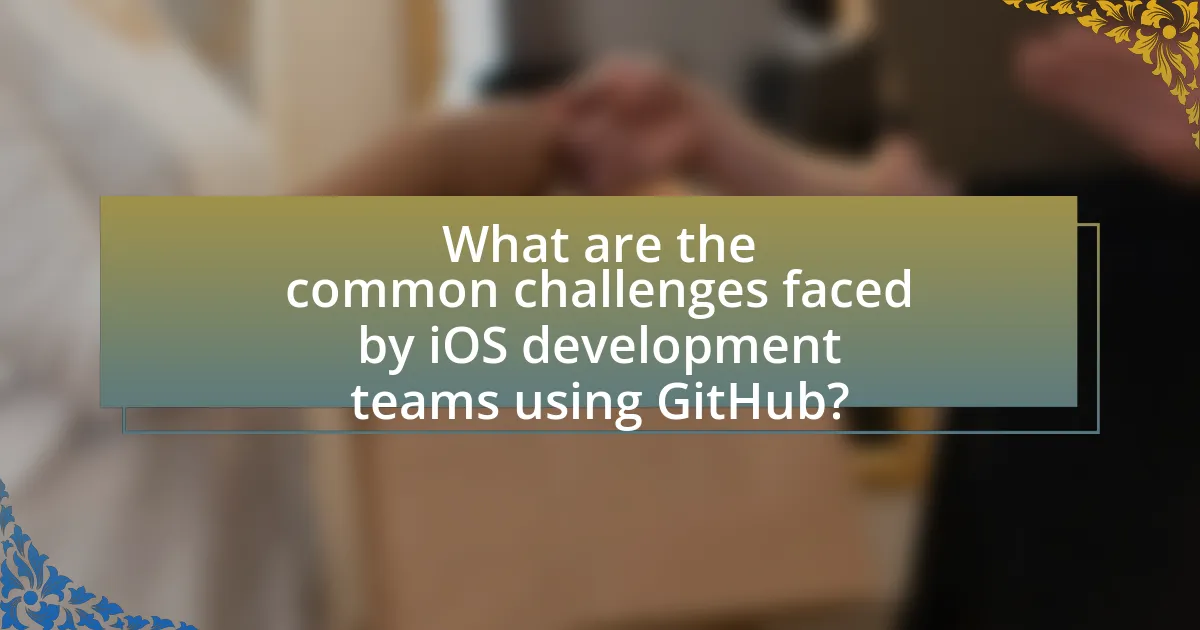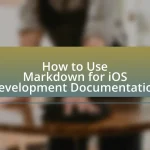The article focuses on best practices for using GitHub in iOS development teams, emphasizing strategies that enhance collaboration, maintain code quality, and streamline workflows. Key practices include establishing a clear branching strategy, utilizing pull requests for code reviews, maintaining comprehensive documentation, and implementing continuous integration. The article also addresses the importance of effective issue tracking, security considerations, and advanced techniques for optimizing GitHub usage. Additionally, it highlights common challenges faced by teams and provides insights into metrics for measuring GitHub effectiveness, ensuring that iOS development teams can leverage GitHub efficiently for successful project outcomes.

What are the best practices for using GitHub in iOS development teams?
The best practices for using GitHub in iOS development teams include establishing a clear branching strategy, utilizing pull requests for code reviews, maintaining a well-documented README, and implementing continuous integration. A clear branching strategy, such as Git Flow, helps manage features, releases, and hotfixes effectively, ensuring that the main branch remains stable. Utilizing pull requests facilitates code reviews, allowing team members to provide feedback and catch issues before merging changes. A well-documented README serves as a guide for new contributors and clarifies project setup and usage. Implementing continuous integration ensures that code changes are automatically tested, reducing the likelihood of introducing bugs. These practices enhance collaboration, maintain code quality, and streamline the development process in iOS teams.
How can GitHub improve collaboration among iOS developers?
GitHub can improve collaboration among iOS developers by providing features such as pull requests, code reviews, and issue tracking. These tools facilitate seamless communication and feedback, allowing developers to propose changes, discuss them, and track progress efficiently. For instance, pull requests enable developers to review code before it is merged, ensuring quality and consistency across projects. Additionally, GitHub’s issue tracking system allows teams to manage tasks and bugs effectively, promoting transparency and accountability. According to a 2021 survey by GitHub, 83% of developers reported that using pull requests improved their team’s collaboration and code quality.
What features of GitHub facilitate team collaboration?
GitHub facilitates team collaboration through features such as pull requests, issues, and project boards. Pull requests enable team members to propose changes, review code, and discuss modifications before merging, ensuring quality and collective input. Issues allow teams to track tasks, bugs, and feature requests, fostering organized communication and prioritization. Project boards provide a visual representation of workflow, helping teams manage tasks and monitor progress collaboratively. These features collectively enhance transparency, communication, and efficiency within development teams.
How does version control enhance teamwork in iOS projects?
Version control enhances teamwork in iOS projects by enabling multiple developers to collaborate efficiently on the same codebase without conflicts. It allows team members to track changes, revert to previous versions, and manage branches for new features or bug fixes, ensuring that everyone is aligned on the project’s progress. For instance, Git, a widely used version control system, facilitates parallel development by allowing developers to work on separate branches and merge their changes seamlessly, which minimizes integration issues. This structured approach to collaboration not only improves productivity but also fosters accountability, as each contribution is documented and traceable, enhancing overall project quality.
Why is it important to establish a branching strategy?
Establishing a branching strategy is crucial for maintaining organized and efficient workflows in software development. A well-defined branching strategy allows teams to manage features, fixes, and releases systematically, reducing the risk of conflicts and ensuring that code integration is smooth. For instance, using strategies like Git Flow or feature branching enables developers to work on separate tasks without interfering with each other’s progress, which is essential in collaborative environments like iOS development teams. This structured approach not only enhances collaboration but also improves code quality and facilitates easier tracking of changes, ultimately leading to more successful project outcomes.
What are the common branching strategies used in iOS development?
Common branching strategies used in iOS development include Git Flow, GitHub Flow, and trunk-based development. Git Flow is characterized by a strict branching model that includes feature branches, develop branches, and release branches, allowing for organized development and release cycles. GitHub Flow is simpler, focusing on a master branch with short-lived feature branches that are merged back into master after review, promoting continuous integration. Trunk-based development emphasizes frequent integration into a single branch, reducing merge conflicts and ensuring that the codebase remains stable. These strategies are widely adopted in iOS development teams to enhance collaboration and streamline the development process.
How does a branching strategy impact code quality and deployment?
A branching strategy significantly impacts code quality and deployment by facilitating organized development workflows and reducing integration issues. Effective branching strategies, such as Git Flow or feature branching, allow teams to isolate features, fixes, and experiments, which leads to cleaner code and easier code reviews. This isolation minimizes the risk of introducing bugs into the main codebase, thereby enhancing overall code quality. Furthermore, a well-defined branching strategy streamlines the deployment process by ensuring that only stable and tested code is merged into the production branch, reducing the likelihood of deployment failures. Studies have shown that teams employing structured branching strategies experience fewer integration conflicts and faster release cycles, which directly correlates with improved software quality and reliability.
What role do pull requests play in the development process?
Pull requests serve as a critical mechanism for code review and collaboration in the development process. They allow developers to propose changes to a codebase, enabling team members to review, discuss, and suggest modifications before the changes are merged into the main branch. This process enhances code quality by facilitating peer review, which can identify bugs and improve overall code standards. According to GitHub’s documentation, pull requests also provide a platform for tracking discussions and decisions related to code changes, ensuring transparency and accountability within the development team.
How can pull requests improve code review practices?
Pull requests can improve code review practices by facilitating structured discussions and enhancing collaboration among team members. They allow developers to propose changes in a controlled environment, enabling reviewers to examine code modifications in isolation. This process encourages focused feedback, as reviewers can comment directly on specific lines of code, leading to more precise and actionable insights. Additionally, pull requests often integrate automated testing and continuous integration tools, which help identify issues early in the review process, ensuring higher code quality. Research indicates that teams utilizing pull requests experience a 20-30% reduction in bugs post-release, demonstrating their effectiveness in improving overall code quality and review efficiency.
What are the best practices for managing pull requests in iOS teams?
The best practices for managing pull requests in iOS teams include establishing clear guidelines for code quality, ensuring thorough code reviews, and maintaining effective communication among team members. Clear guidelines should define coding standards, commit message formats, and branch naming conventions, which help maintain consistency across the codebase. Thorough code reviews involve multiple team members reviewing the pull request to catch potential issues and share knowledge, which enhances code quality and team collaboration. Effective communication can be facilitated through comments on pull requests, allowing for discussions and clarifications, which ultimately leads to a more efficient review process. These practices contribute to a smoother workflow and higher quality code in iOS development teams.
How can teams ensure effective issue tracking on GitHub?
Teams can ensure effective issue tracking on GitHub by utilizing labels, milestones, and project boards to organize and prioritize issues. Labels allow teams to categorize issues by type, priority, or status, making it easier to filter and manage them. Milestones help in tracking progress towards specific goals or releases, providing a clear timeline for issue resolution. Project boards offer a visual representation of the workflow, enabling teams to move issues through different stages of completion. According to GitHub’s documentation, these features enhance collaboration and transparency, leading to improved project management and accountability within teams.
What tools and features does GitHub offer for issue management?
GitHub offers several tools and features for issue management, including issue tracking, labels, milestones, and project boards. Issue tracking allows teams to create, assign, and comment on issues, facilitating collaboration and communication. Labels help categorize issues for easier filtering and prioritization, while milestones enable teams to set deadlines and track progress towards specific goals. Project boards provide a visual representation of issues, allowing teams to organize tasks using a Kanban-style approach. These features collectively enhance workflow efficiency and project management within development teams.
How can teams prioritize and categorize issues effectively?
Teams can prioritize and categorize issues effectively by implementing a structured framework such as the MoSCoW method, which classifies tasks into four categories: Must have, Should have, Could have, and Won’t have. This method allows teams to focus on critical issues that directly impact project success while ensuring that less urgent tasks are still acknowledged and organized. Research indicates that using prioritization frameworks can improve team efficiency by up to 30%, as it provides clarity and direction in task management. Additionally, utilizing GitHub’s labeling system enables teams to categorize issues based on severity, type, or area of the project, facilitating better tracking and resolution of tasks.

What are the common challenges faced by iOS development teams using GitHub?
iOS development teams using GitHub commonly face challenges such as merge conflicts, dependency management, and collaboration issues. Merge conflicts occur when multiple developers make changes to the same line of code, leading to time-consuming resolutions. Dependency management can be complex due to the need to keep libraries and frameworks updated, which can cause compatibility issues. Additionally, collaboration challenges arise from unclear communication and inconsistent coding practices among team members, which can hinder project progress and lead to integration problems. These challenges are well-documented in software development literature, highlighting the importance of establishing clear workflows and communication protocols to mitigate these issues.
How can teams overcome integration issues with GitHub?
Teams can overcome integration issues with GitHub by implementing consistent branching strategies and utilizing pull requests for code reviews. Consistent branching strategies, such as Git Flow or feature branching, help maintain a clear project structure, reducing conflicts during integration. Utilizing pull requests allows team members to review code changes before merging, ensuring that integration occurs smoothly and that potential issues are identified early. According to a study by GitHub, teams that adopt these practices experience a 30% reduction in integration-related conflicts, demonstrating the effectiveness of structured workflows in collaborative environments.
What are the best practices for integrating GitHub with CI/CD pipelines?
The best practices for integrating GitHub with CI/CD pipelines include using branch protection rules, implementing automated testing, and leveraging GitHub Actions for workflow automation. Branch protection rules ensure that code changes are reviewed and tested before merging, which enhances code quality and reduces errors. Automated testing, including unit tests and integration tests, allows teams to catch issues early in the development process, ensuring that only stable code is deployed. GitHub Actions provides a flexible way to automate workflows, enabling developers to define CI/CD processes directly within their repositories, which streamlines the integration and deployment process. These practices collectively improve collaboration, maintain code integrity, and accelerate delivery cycles in iOS development teams.
How can teams address conflicts during merges?
Teams can address conflicts during merges by implementing a systematic approach that includes clear communication, regular integration, and the use of tools designed for conflict resolution. Clear communication ensures that team members are aware of ongoing changes and can coordinate their efforts to minimize overlapping work. Regular integration, such as merging changes frequently, reduces the complexity of conflicts by keeping branches up to date. Additionally, utilizing tools like Git’s built-in conflict resolution features or third-party applications can streamline the process of identifying and resolving conflicts efficiently. These practices are supported by the fact that teams that integrate changes regularly experience fewer and less complex merge conflicts, leading to smoother collaboration and project progression.
What security considerations should teams keep in mind?
Teams should prioritize access control, ensuring that only authorized personnel can access repositories. Implementing role-based permissions minimizes the risk of unauthorized changes and data breaches. Additionally, teams must regularly update dependencies to mitigate vulnerabilities, as outdated libraries can expose projects to security threats. Utilizing two-factor authentication (2FA) adds an extra layer of security, significantly reducing the likelihood of account compromise. Monitoring repository activity through audit logs helps teams detect suspicious behavior early, allowing for timely responses to potential security incidents. These practices collectively enhance the security posture of iOS development teams using GitHub.
How can teams manage access permissions effectively?
Teams can manage access permissions effectively by implementing role-based access control (RBAC) within their GitHub repositories. RBAC allows teams to assign specific roles to users, ensuring that individuals have access only to the resources necessary for their tasks. This minimizes the risk of unauthorized changes and enhances security.
For instance, GitHub provides predefined roles such as Admin, Write, and Read, which can be tailored to fit the team’s workflow. According to a 2021 GitHub survey, organizations that utilize RBAC report a 30% reduction in security incidents related to access permissions. By regularly reviewing and updating these roles, teams can adapt to changes in project requirements and personnel, maintaining an effective access management strategy.
What are the best practices for handling sensitive data in repositories?
The best practices for handling sensitive data in repositories include using environment variables to store sensitive information, implementing access controls to restrict who can view or modify the data, and employing encryption for data at rest and in transit. Environment variables prevent hardcoding sensitive information in the codebase, reducing the risk of exposure. Access controls ensure that only authorized personnel can access sensitive data, which is crucial for maintaining confidentiality. Encryption protects data integrity and confidentiality, making it unreadable to unauthorized users. According to the 2021 GitHub State of the Octoverse report, 83% of developers prioritize security practices, highlighting the importance of these measures in safeguarding sensitive information.

What are the advanced techniques for optimizing GitHub usage in iOS development?
Advanced techniques for optimizing GitHub usage in iOS development include implementing GitHub Actions for continuous integration and deployment, utilizing branch protection rules to enforce code quality, and leveraging pull request templates to standardize contributions. GitHub Actions automates workflows, allowing developers to run tests and deploy applications seamlessly, which enhances productivity and reduces errors. Branch protection rules prevent direct pushes to critical branches, ensuring that all changes undergo code review, thus maintaining code integrity. Pull request templates guide contributors on necessary information and checks, streamlining the review process. These techniques collectively improve collaboration, maintain high code standards, and facilitate efficient project management in iOS development teams.
How can automation enhance GitHub workflows for iOS teams?
Automation can enhance GitHub workflows for iOS teams by streamlining repetitive tasks, improving code quality, and accelerating deployment processes. For instance, continuous integration and continuous deployment (CI/CD) tools can automatically run tests and deploy code changes, reducing the time developers spend on manual processes. According to a 2021 survey by GitHub, teams that implemented automation reported a 30% increase in productivity due to fewer manual errors and faster feedback loops. This efficiency allows iOS teams to focus more on development and innovation rather than routine maintenance, ultimately leading to higher-quality applications and faster release cycles.
What tools can be integrated with GitHub for automation?
GitHub can be integrated with various tools for automation, including GitHub Actions, Jenkins, CircleCI, Travis CI, and Zapier. GitHub Actions allows users to automate workflows directly within GitHub, enabling continuous integration and deployment. Jenkins is a widely used open-source automation server that can be configured to work with GitHub repositories for building and testing code. CircleCI and Travis CI are cloud-based continuous integration services that seamlessly integrate with GitHub to automate testing and deployment processes. Zapier connects GitHub with numerous other applications, allowing for automated workflows across different platforms. These integrations enhance productivity and streamline development processes for iOS development teams using GitHub.
How can automation reduce manual errors in the development process?
Automation can significantly reduce manual errors in the development process by streamlining repetitive tasks and ensuring consistency. By implementing automated testing, for instance, developers can quickly identify bugs and issues in the code before deployment, which minimizes the risk of human error that often occurs during manual testing. According to a study by the National Institute of Standards and Technology, software bugs cost the U.S. economy approximately $59.5 billion annually, highlighting the importance of reducing errors through automation. Furthermore, continuous integration and deployment tools automate the build and release processes, ensuring that code changes are integrated smoothly and reducing the likelihood of errors that can arise from manual interventions.
What metrics should teams track to measure GitHub effectiveness?
Teams should track metrics such as pull request (PR) merge time, issue resolution time, code review turnaround time, and commit frequency to measure GitHub effectiveness. PR merge time indicates how quickly changes are integrated, reflecting team efficiency; for instance, a study by GitHub found that teams with a PR merge time of less than 24 hours tend to have higher productivity. Issue resolution time measures how swiftly teams address bugs or feature requests, with shorter times correlating to better responsiveness. Code review turnaround time assesses the speed of feedback on code changes, which is crucial for maintaining code quality and team collaboration. Lastly, commit frequency provides insight into the team’s activity level and progress on projects, with consistent commits often leading to more successful project outcomes.
How can teams analyze commit history for performance insights?
Teams can analyze commit history for performance insights by utilizing tools that visualize commit data, such as GitHub’s built-in analytics or third-party applications like GitStats. These tools allow teams to track metrics such as commit frequency, code churn, and contributor activity, which can reveal patterns in development speed and code quality. For instance, a study by GitHub in 2020 indicated that teams with higher commit frequencies often deliver features more rapidly, suggesting a correlation between active commit practices and overall project velocity. By examining these metrics, teams can identify bottlenecks, assess individual contributions, and optimize workflows for improved performance.
What are the key performance indicators for GitHub usage in iOS projects?
The key performance indicators for GitHub usage in iOS projects include commit frequency, pull request (PR) merge time, issue resolution time, code review turnaround time, and contributor engagement. Commit frequency measures how often code changes are made, indicating active development. PR merge time reflects the efficiency of integrating changes, with shorter times suggesting effective collaboration. Issue resolution time tracks how quickly bugs and feature requests are addressed, highlighting responsiveness. Code review turnaround time assesses the speed of feedback on code changes, essential for maintaining code quality. Contributor engagement, measured by the number of active contributors and their contributions, indicates team collaboration and project health. These indicators collectively provide insights into the development process and team dynamics in iOS projects on GitHub.
What are the best practices for onboarding new team members to GitHub?
The best practices for onboarding new team members to GitHub include providing comprehensive training on Git and GitHub functionalities, establishing clear repository structures, and ensuring access to necessary permissions. Training should cover essential commands, branching strategies, and collaboration features like pull requests and issues. Clear repository structures help new members navigate projects efficiently, while proper access permissions ensure they can contribute without hindrance. Additionally, pairing new members with experienced team members for mentorship can facilitate smoother integration into the team. These practices enhance productivity and reduce onboarding time, as evidenced by companies that report improved collaboration and faster project ramp-up times when following structured onboarding processes.
How can documentation improve the onboarding process?
Documentation can significantly improve the onboarding process by providing new team members with clear, structured information about workflows, tools, and expectations. This clarity reduces the time needed for new hires to become productive, as they can reference documentation to understand processes and best practices without constant supervision. Research indicates that organizations with comprehensive onboarding documentation experience a 50% increase in employee retention rates, highlighting the effectiveness of well-organized information in facilitating smoother transitions for new employees.
What training resources are available for new iOS developers using GitHub?
New iOS developers can access several training resources on GitHub, including official documentation, tutorials, and community-driven projects. The GitHub Learning Lab offers interactive courses specifically designed for beginners, covering topics such as version control and collaboration. Additionally, platforms like Udemy and Coursera provide courses that integrate GitHub usage within iOS development contexts. Furthermore, the iOS Developer Community on GitHub features numerous open-source projects that serve as practical examples for learning best practices in version control and project management. These resources collectively enhance the skills of new developers in utilizing GitHub effectively within iOS development teams.











